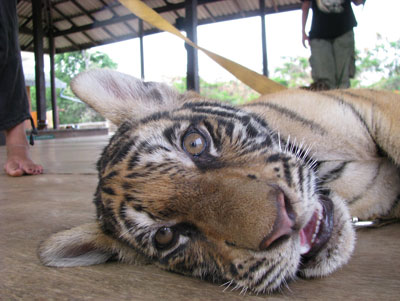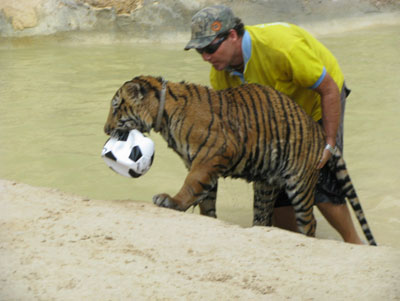Taking a walk on the wild side at Thailand’s Tiger Temple
by Teresa O'Kane, San Jose, CA
In Koh Chang, Thailand, we met an 18-year-old Canadian girl who told my husband, Scott, and me about the Tiger Temple outside Kanchanaburi. “You can touch tigers!” she said.
So we took a ferry to a bus to a third-class train to a second-class bus, then a motorcycle with sidecar to Kanchanaburi. It only took two days to get there!
A laid-back start
The opportunities to touch tigers at the temple started in the afternoon when the tigers were hot, full and sleepy — a good time to touch a tiger anywhere, I guess. At 3:30 we wound our way through the grounds to a canyon where eight adult tigers lay in the hot sun. Most of them were asleep.
Two uniformed Thai teenagers led paying visitors one by one to a tiger. We were instructed to sit down “very quietly” next to the tiger for a photo using our camera.
A monk came over as I sat next to a tiger and lifted the tiger’s huge head into my lap. Another tiger rolled on his back for a tummy rub. I complied.
There were a few volunteers from Europe who did things like remind everyone in English that the tigers are wild, to stay quiet and to follow the directions of the Thai teenagers.
The visit with the tigers each day is short and sweet because even though the cats are sleepy and laid-back 20 hours a day, there are those four hours when they are doing things that tigers do when they are awake, like scratching, biting, growling and looking for something to eat. We got to see all that and more the next day.
Walk on the wild side
After our tiger photo op, one of the volunteers said to me, “You obviously like cats very much. I have to check with Rod to see if it’s okay, but if you come back tomorrow morning you can eat breakfast with the monks and interact with the tigers one on one.”
We returned to our accommodations for the night, a lovely Balinese-style hotel called The Ploy (phone +66 034 515 804, www.ploygh.com). Our room, with a private garden and open-air bath, was very romantic.
The rate for this type of room is 850-950 baht ($23-$26) per night, with standard rooms starting at 650 baht ($18). The room rates available online are an incredible 570-700 baht ($16-$19). Breakfast (coffee and toast) is included, and they offer free pickup service from the train or bus station.
At the crack of dawn, a guy who brings food for the tigers every day drove us back out to the temple where we again met Rod, the young and enthusiastic former Canadian who is in charge of the tigers. After we signed a liability waiver and made a donation, Rod smiled broadly and said, “Let’s go walk some tigers!”
We walked past wild boars, antelope, peacocks, horses and buffalo before coming to a tree where four tiger cubs on leashes were playing in the shade. Imagine four very hyperactive 2-year-old boys bouncing off the walls with pent-up energy and you’ll have the image of these 3-month-old cubs.
We each were assigned our cub and handed a leash. Immediately the tigers leapt at our legs, scratching and biting. Rod said, “Just tap them on the nose if they bite you.” We proceeded to nose tap for the next five minutes.
The cubs thought we were playing, so we changed tactics. My husband and I walked close enough to each other so that the cubs would attack each other instead of our legs. There was a lot of leash tangling but fewer scratches and nips to our legs.
The cubs were so cute we just wanted to pick them up to snuggle them, but they rarely even made eye contact with us, treating us like walking trees on which to sharpen their claws. It was a tiring walk to the place where we were to eat breakfast with the monks, and sometimes we had to push the cubs along or even carry them a ways, but we were grinning from ear to ear.
Morning with the monks
Once we arrived at the sala, a platform where the monks chant, meditate and eat, we were given warm bottles of milk to feed our cubs. As soon as the bottles went into their mouths they became completely docile and all warm and cuddly, closing their eyes and pushing their big paws against our bodies. I could have done that all day, but the cubs made short work of the milk.
Then we were told to put the cubs under the sala at our feet, where they immediately fell asleep.
We had been asked the previous day to bring food for the monks. We asked what they loved and were told, “Bring fruit. But if you bring Coca-Cola® you would really make the monks happy.”
Locals bring food to the monks daily, and the spread set before them was more a feast than breakfast — about 10 Thai entrées plus rice, fruit, brownies and the nuts and Coke we provided, which were indeed appreciated by the monks.
Before breakfast the monks chanted, and I guessed that we were supposed to be meditating or something because everyone had their eyes shut or hands clasped in prayer. I spent the chant rubbing my cub with my toes while he slept. Ohhhhhmmmmmmm.
After prayer, the monks ate first, then, as guests, Scott and I were asked to go next, followed by six volunteers and about two dozen fearless Thai teens and twenty-somethings who worked at the temple with the tigers. While the monks ate, they were able to watch a 32-inch TV tuned to BBC news. Who doesn’t like a little news with their brekkie?
Caged enthusiasm
After breakfast, we had a heck of a time waking the cubs and getting them to their cages. They seemed so sleepy, until we arrived at the cages. That was when Rod turned to us and said, “Okay, now you get to be locked in a cage with your cubs for 30 minutes!”
The cubs heard that and perked up considerably. “Oh, good, some legs and feet to bite in an enclosed area!”
The cage was 6 feet long by 3 feet wide by 4 feet tall. In went Scott, me and two wigged-out cubs. Fortunately, there were cub toys inside the cage, mostly consisting of punctured balls and some knotted rope.
As the cubs leapt around trying to tackle and bite us, we quickly learned to have something on hand at all times to shove in their gaping jaws so we wouldn’t end up punctured like the balls.
As tiring as it was to constantly distract the cubs, we had one of the best half hours of our lives in that little cage.
Tiger play
Next we got to walk some big tigers down to the water hole for exercise. And, boy, were they big!
Dan, the volunteer who walked with my tiger and me, had received a small nip on his finger a few days before so was keen on instructing me what to do if a tiger bit me.
“First, you must not try to pull your limb out of the tiger’s mouth. If you do that, they will lock their jaws around you and it will take us 15 minutes to get you free. Instead, you must push your limb further into their mouths and they will release after a few minutes.”
“Okay,” I said, as I lengthened my leash and walked a few more paces back from the tiger’s mouth.
We were told that no one had ever been attacked by one of their tigers.
After we finally arrived at the canyon, I understood why the tigers were so sleepy the day before and why they allowed people to touch them. As soon as we let the tigers off their leads, they jumped into the water and romped and clawed and bit and ran and chased and pounced and stalked.
For the next 90 minutes the water hole became a stormy sea churned up by tiger play. They played like maniacs, except for one tiger that took about two minutes to puncture a soccer ball, then sat in the water the whole time with the ball in his mouth not letting any other tiger have it.
Stay behind the line
Before we had let the tigers off their leashes, Rod drew a semicircle in the dirt with a stick, saying, “If you stay within this line, you won’t be attacked.”
I laughed since I thought he was making a joke. He was serious.
Rod and three male volunteers took their thin bamboo rods and formed a very leaky barrier between the tigers and the canyon exit while the tigers went wild just a few feet from where we stood inside our protective line in the dirt.
The tigers stayed in the water, for the most part, but sometimes they got so rambunctious they chased one another out of the water hole. Rod and the other three guys would then point their “toothpicks” at the tigers and say “Back to the water!” in Thai. This totally cracked me up, but it caused a bit of apprehension too. As I looked around, I could see that Scott and I had way more marbling on us than any of the other humans there at the water hole.
When playtime was over, it was time to get the exhausted tigers out of the water, which turned out to be a bit tricky. Rod turned his back on the tigers and crouched down. The tigers immediately went into stalking mode and ran out of the water to pounce on him, the other three guys pouncing on the tiger just before it got to Rod.
The tiger with the ball in his mouth had to be pushed from the rear and carried out of the water. They do this every day.
After we finally got the tigers back to their cages, Scott and I had to give them each a bath. It was like washing a dog — a really big dog.
Planning a visit
The Tiger Temple (77 Mu 5 Tambon Singh, Sai Yok District) is located in Kanchanaburi Province. Any area guest house can arrange transport out to the temple and back. (The Tiger Temple itself does not arrange tours.)
The monastery is open to the public from noon to 3 p.m. Arrive early to get a chance to touch the tigers.
The cost of admission was around $10. A further donation of $20 was required to have our photo taken with the tigers.
At the time of our visit, in March ’08, a maximum of three people could attend Sunday breakfast with the monks, and this could not be reserved in advance.
Check the website (www.tigertemple.org) for more information.




